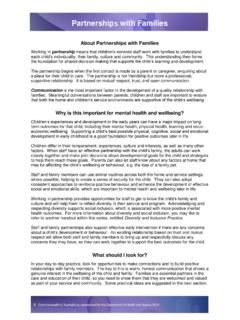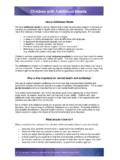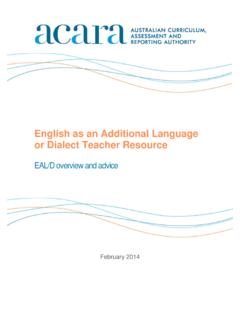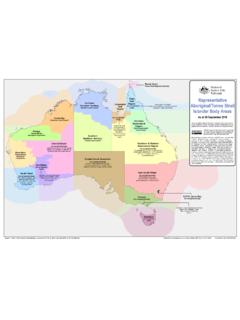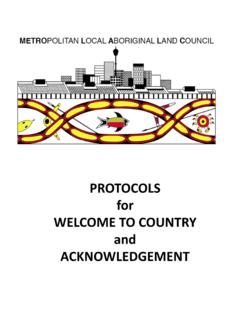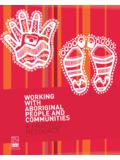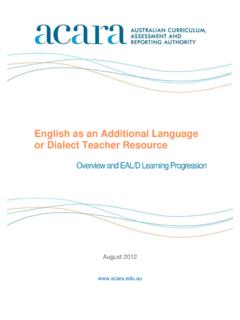Transcription of Aboriginal and Torres Strait Islander Communities
1 Commonwealth of Australia 2005 1 response ability Aboriginal and Torres Strait Islander refers to persons of Aboriginal and/or Torres Strait Islander descent, who identify as Aboriginal and/or Torres Strait Islander and are accepted as such by the community in which they live. There are three key factors to be mindful of when exploring concepts of Aboriginal and Torres Strait Islander wellbeing: the wide-ranging impact of European colonisation; the influence of geographical and cultural dimensions on individuals and Communities ; and the barriers, historical and current, to obtaining a comprehensive picture of Aboriginal and Torres Strait Islander health and wellbeing. This document broadly discusses the historical and contextual factors that impact upon Aboriginal and Torres Strait Islander Communities in regard to social and emotional wellbeing, mental health problems, illness and treatment.
2 It also outlines considerations for educators, with a focus on the perspective of pre-service and early career teachers. Historical Background Any consideration of Aboriginal and Torres Strait Islander mental health must be set within the framework of Australian history. Estimates of the population of Australia prior to European colonisation vary but there may have been over one million Aboriginal and Torres Strait Islander inhabitants. There were many different I Aboriginal and Torres Strait Islander groups and hundreds of languages. However, the population declined rapidly after colonisation and by the 1920s there were only around 60,000 Aboriginal and Torres Strait Islander people. European colonisation had wide reaching effects: Aboriginal and Torres Strait Islander people were forced off their traditional lands, away from their active hunter-gatherer lifestyle.
3 Some Aboriginal and Torres Strait Islander groups resisted the seizure of their lands, resulting in violence. Many Aboriginal and Torres Strait Islander people died from infectious diseases brought into the country by Europeans. Many Aboriginal and Torres Strait Islander people were moved to missions or reserves, where they were forbidden to speak their own language or maintain their cultural practices. Laws were enacted, limiting the rights of Aboriginal and Torres Strait Islander people, segregating them from other Australians and giving them little or no self-determination. Aboriginal and Torres Strait Islander children were forcibly removed from their families and Communities , to be raised in institutions or by foster families of European background. ??Many Aboriginal and Torres Strait Islander people suffered physical or sexual abuse in institutions, or lived in servitude or poverty as labourers and domestic workers.
4 Many lost their language and cultural identity as they were expected to adopt European dress, language, religion, lifestyle and cultural values. ??Many were prevented from having any contact with their Aboriginal and Torres Strait Islander family, even by letter - some later tried to reunite with their families, with mixed results. The practice of removing Aboriginal and Torres Strait Islander children from their families existed from the earliest days of British settlement and reached its peak between 1910 and 1970. A national inquiry has since found that the practice was undertaken deliberately and Aboriginal and Torres Strait Islander : Social and Emotional Wellbeing Commonwealth of Australia 2005 2 response ability systematically, with the aim of assimilating children into non- Aboriginal and Torres Strait Islander families so that their unique cultures and identities would be lost.
5 While the reason given for removal was often the children s wellbeing, evidence suggests that their outcomes were frequently less positive than those who remained with their Aboriginal and Torres Strait Islander families. Further information about the findings of the inquiry can be found at: European colonisation, family disruption, cultural displacement and discrimination contributed to a high incidence of poverty, unemployment, homelessness and poor health in Australia s Aboriginal and Torres Strait Islander Communities . Many Aboriginal and Torres Strait Islander people today continue to experience discrimination and social disadvantage. Indigenous Australia Today At the 2001 Census, there were an estimated 458,000 Aboriginal and Torres Strait Islander people living in Australia, comprising of the total Australian population.
6 It is estimated that the Aboriginal and Torres Strait Islander population will grow to more than 550,000 people by 2011 (Hunter, 2003). In 2001, over half of the Aboriginal and Torres Strait Islander population resided in just two states: New South Wales and Queensland. The Northern Territory had the highest proportion of Aboriginal and Torres Strait Islander people, as a percentage of its total population, at 29%. The majority of Aboriginal and Torres Strait Islander people (69%) lived outside the major urban centres, with one in four Aboriginal or Torres Strait islanders living in remote areas. 80% of Aboriginal and Torres Strait Islander people speak only English at home while 12% report speaking an Aboriginal or Torres Strait Islander language at home (HREOC, 2004). Many Aboriginal and Torres Strait islanders live in situations of socio-economic disadvantage, including homelessness, poverty or unemployment.
7 Such settings are associated with higher levels of poor nutrition, excessive alcohol consumption, smoking and lack of physical activity (Thomson et al., 2004). These factors contribute significantly to the incidence and severity of physical and mental illnesses in individuals and the community. Measures of Health in Indigenous Communities Aboriginal and Torres Strait islanders have traditionally viewed health as including not only the physical health of the individual, but also the social, emotional and spiritual wellbeing of the whole community. Traditional Aboriginal and Torres Strait Islander culture also features a strong bond with the land and a personal connection to the lands of one's own people. This plays an important part in the Aboriginal and Torres Strait Islander sense of identity and the mental health of Aboriginal and Torres Strait islanders .
8 Many Aboriginal and Torres Strait Islander Communities prefer the term social and emotional wellbeing to mental health, as it reflects a more positive and holistic approach to health (Australian Health Ministers, 2003). When analysing the incidence of health problems among Aboriginal and Torres Strait islanders , statistics about hospital admissions or attendance at health services are the major sources of Commonwealth of Australia 2005 3 response ability information. A decision to attend a health care facility is influenced by cultural factors and by perceptions about health and medical services. Factors characterised by others as symptoms of ill health pain or discomfort, negative feelings, delusions or hallucinations could be experienced by some Aboriginal and Torres Strait Islander people as a personal or spiritual issue, or the result of a cultural transgression.
9 An Aboriginal and Torres Strait Islander person may feel it is not helpful or appropriate to discuss certain issues with a health worker, particularly where there are cultural or gender differences. Some Aboriginal and Torres Strait Islander people only attend a hospital or health service when ill health has become severe, or may have limited access to facilities in their local area. There are likely to be many people who are cared for in the community or who have illnesses which are undiagnosed. Furthermore, there has often been inadequate information about whether people attending health services identify as Aboriginal or Torres Strait Islander although many health services nationally are taking steps to remedy this and collect more comprehensive statistics. Such issues should be kept in mind when considering measures of health in Aboriginal and Torres Strait Islander Communities .
10 The estimated life expectancy of Aboriginal and Torres Strait Islander people is 20 years lower for males and 19 years lower for females, as compared with non- Aboriginal and Torres Strait islanders (Australian Health Ministers, 2004). Aboriginal and Torres Strait Islander people have higher mortality rates across all age groups, particularly in the age range 35 to 54, where rates are 5 to 6 times higher than for the population as a whole. For the period 1999 to 2003, the infant mortality rate for Aboriginal and Torres Strait Islander babies was three times higher than non- Aboriginal and Torres Strait Islander infants. Aboriginal and Torres Strait Islander people are less likely than non- Aboriginal and Torres Strait Islander people to drink alcohol, but those who do drink are more likely to consume it at hazardous levels (ABS & AIHW, 2003).
